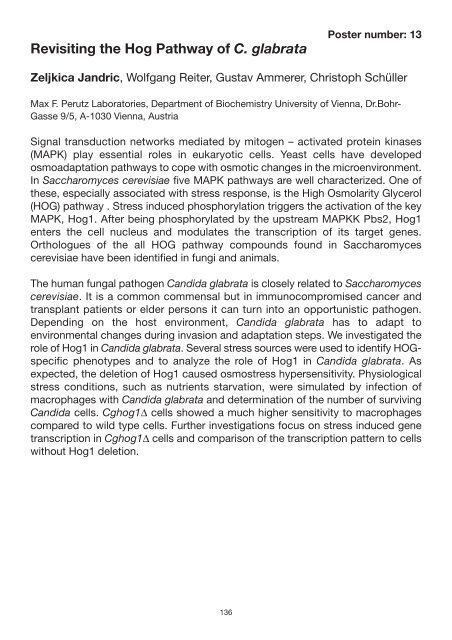Candida Infection Biology – fungal armoury, battlefields ... - FINSysB
Candida Infection Biology – fungal armoury, battlefields ... - FINSysB
Candida Infection Biology – fungal armoury, battlefields ... - FINSysB
Create successful ePaper yourself
Turn your PDF publications into a flip-book with our unique Google optimized e-Paper software.
Revisiting the Hog Pathway of C. glabrata<br />
136<br />
Poster number: 13<br />
Zeljkica Jandric, Wolfgang Reiter, Gustav Ammerer, Christoph Schüller<br />
Max F. Perutz Laboratories, Department of Biochemistry University of Vienna, Dr.Bohr-<br />
Gasse 9/5, A-1030 Vienna, Austria<br />
Signal transduction networks mediated by mitogen – activated protein kinases<br />
(MAPK) play essential roles in eukaryotic cells. Yeast cells have developed<br />
osmoadaptation pathways to cope with osmotic changes in the microenvironment.<br />
In Saccharomyces cerevisiae five MAPK pathways are well characterized. One of<br />
these, especially associated with stress response, is the High Osmolarity Glycerol<br />
(HOG) pathway . Stress induced phosphorylation triggers the activation of the key<br />
MAPK, Hog1. After being phosphorylated by the upstream MAPKK Pbs2, Hog1<br />
enters the cell nucleus and modulates the transcription of its target genes.<br />
Orthologues of the all HOG pathway compounds found in Saccharomyces<br />
cerevisiae have been identified in fungi and animals.<br />
The human <strong>fungal</strong> pathogen <strong>Candida</strong> glabrata is closely related to Saccharomyces<br />
cerevisiae. It is a common commensal but in immunocompromised cancer and<br />
transplant patients or elder persons it can turn into an opportunistic pathogen.<br />
Depending on the host environment, <strong>Candida</strong> glabrata has to adapt to<br />
environmental changes during invasion and adaptation steps. We investigated the<br />
role of Hog1 in <strong>Candida</strong> glabrata. Several stress sources were used to identify HOGspecific<br />
phenotypes and to analyze the role of Hog1 in <strong>Candida</strong> glabrata. As<br />
expected, the deletion of Hog1 caused osmostress hypersensitivity. Physiological<br />
stress conditions, such as nutrients starvation, were simulated by infection of<br />
macrophages with <strong>Candida</strong> glabrata and determination of the number of surviving<br />
<strong>Candida</strong> cells. Cghog1∆ cells showed a much higher sensitivity to macrophages<br />
compared to wild type cells. Further investigations focus on stress induced gene<br />
transcription in Cghog1∆ cells and comparison of the transcription pattern to cells<br />
without Hog1 deletion.


